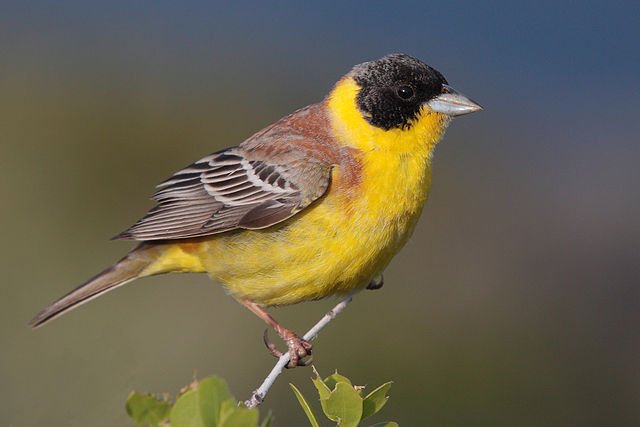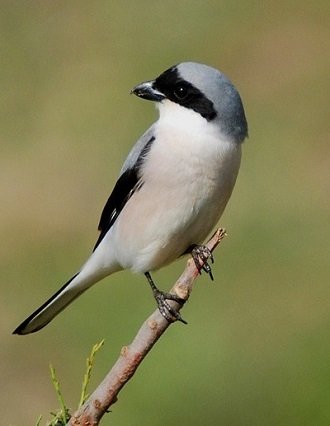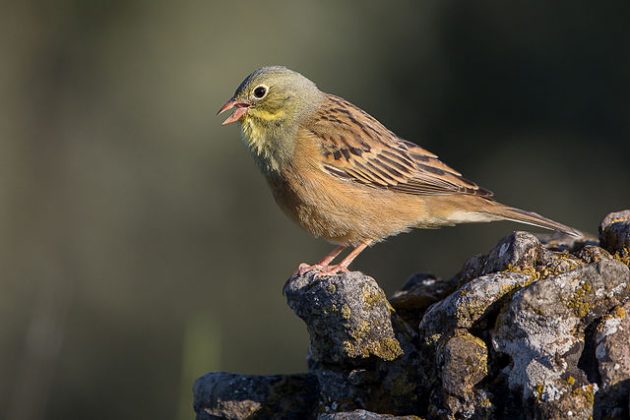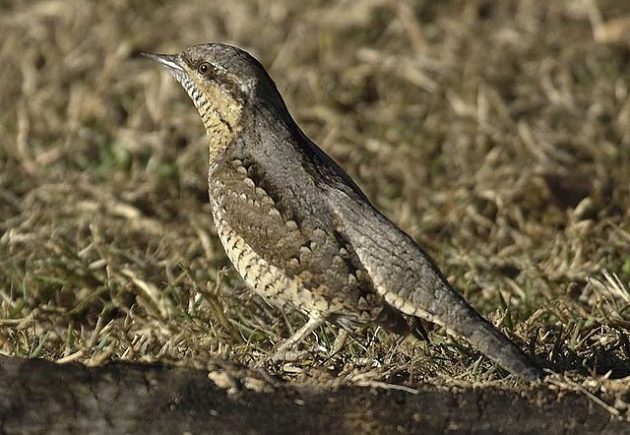
Cover photo: Black-headed Bunting by Mark S. Jobling / Wikimedia Commons
This year, the first heat of the season came late, only with early June. Instead of writing at home, I discovered a new “study”, a discreet fish restaurant hidden in the branch of the Danube. From its garden I can see the river, willows and poplars, and there’s a light breeze bringing freshness from the water, together with surprisingly good local stout and a friendly couple for owners… My kind of study. Back to writing.
The other day I was driving along the Danube embankment inside the Labudovo okno Ramsar site and nature reserve, some 90 km downriver from Belgrade. Following the construction of the Iron Gates Dam, 50 years ago, the Danube water level rose and the river flow slowed down, causing the flooding of several islands and lower banks. Shallows provide an ideal spawning ground for almost 50 fish species and submerged islands breeding ground for more than 100 bird species.
Lesser Grey Shrike by Dûrzan Cîrano / Wikimedia Commons
Looking at the river, I cannot believe my memories of the same place this January – frozen solid, with just a small opening in the ice – and 26,000 geese in it! This morning, there was a usual array of waterbirds*, joined by a singing Yellowhammer and Corn Buntings. Beside several well-showing Red-backed Shrikes, the highlight was one uncommon Lesser Grey Shrike (highly localized**, with only 700 to 1000 breeding pairs in Serbia).
Further down the river, near the village of Zatonje, roadside birds included both Woodlark (showing well on a wire) and Eurasian Skylark (singing in flight), plus two new territories of Black-headed Buntings, with males proudly singing. Until about a decade ago, this warmth-loving species lived only in the south, but then it quickly spread much further, even north of the Danube.
From there, by the Silver Lake (actually Kiseljevacki river arm, but it was renamed because of tourism development) I drive once more through meadows and willow groves along the very bank of the river with its Whiskered and Common Terns, and Sand Martins (Bank Swallows) among the more numerous Barn Swallows. Wait! That song…
I suck at bird songs but this one sounds more like something coming from a pinball machine. Checking my phone, yes, that’s it – the Icterine Warbler. I played it back for a few times, but the singer wouldn’t show.
Then, by the medieval Golubac Citadel the river becomes truly wide, 5.2 km / 3.2 mi. Along the cliffs before the citadel, another great bird shows up – a small flock of Alpine Swifts. They breed at only eight localities in the country, and are estimated at a mere 60-100 pairs. We observed some 15 birds here.
I like driving. And I especially like driving down the Danube. Some lovely landscapes, great habitats and birds, but there’s more. Unexplainably, it feels right to follow the waters towards the delta. Perhaps I am responding to the Danube like the world’s oceans respond to the gravitation of the Moon?
After the village of Dobra and the third bridge with red rails, 4.3 km / 2.7 mi from the first one (inside the village), we turn right into the hills and onto the Forgotten Road birding route. Once upon a time, this narrow forest track was the main international road to Romania, but, back then, Romania was a country behind the curtain and perhaps there wasn’t that much traffic? From open and sunny oak forests into deep, dark and moist shadow of thick beech crowns. Marsh Tits and Hawfinches abound.
 Ortolan Bunting by Pierre Dalous / Wikimedia Commons
Ortolan Bunting by Pierre Dalous / Wikimedia Commons
Eleven kilometres of sneaking through the trees brings us into the open where birds become more numerous and far easier to spot. I park for a while and scan the surroundings.
In front of some hilltop rocks is a broken, dry and pale branch. Or a falcon? No, it isn’t moving, it has to be a branch. Yet, what if it isn’t? I mount my scope, the Swarovski 25-60×65 STX, onto a window clamp and… it’s a bird! Not a falcon, but a female Eurasian Sparrowhawk, drying its soaked feathers after the rain that was falling while we were protected by the trees.
One threatened European Turtle Dove takes flight from a roadside hedge. Another bird, seen from behind, a female Eurasian Blackbird? No, too many markings on its cheek, it’s a Song Thrush, one of many I heard, but the only one seen. Soon it takes flight into an orchard where I cannot see it, but now can hear it singing.
One Yellowhammer singing on the right hand side, two Corn Buntings on the left and… something sings nearby, almost above the car. Searching the leaves of a small tree… if only I could see it… a lovely Ortolan Bunting!
 Eurasian Wryneck by Martien Brand / Wikimedia Commons
Eurasian Wryneck by Martien Brand / Wikimedia Commons
Movement inside a roadside bush, maybe 4 feet from the car. Some bird moves through the bush, but is hidden by leaves at any given moment. Trying to focus my Swarovski 8×30 CL Companion on it, trying to make the leaves transparent… Wow! This sure is a “wow” bird – a Eurasian Wryneck. A heavily camouflaged woodpecker (like an owl or a nightjar), more often heard than seen, and even then, possible to see only when it moves.
More bird-friendly old orchards interspersed by lush flowery meadows as we are going downhill, into exposed sandstone cliffs of a small canyon of the Boljetinska river, where the sunset sky is filled with House Martins.
The heat is on and the waitress is starting the ceiling fan. Time for another stout.
** All population estimates from Birds of Serbia: Breeding Population Estimates and Trends, BirdLife Serbia, 2015.
* The complete birdlist of this tour – 78 species:
Gadwall – Anas strepera
Mallard – Anas platyrhynchos
Garganey – Anas querquedula
Common Pochard – Aythya ferina
Ferruginous Duck – Aythya nyroca
Common Pheasant – Phasianus colchicus
Great Crested Grebe – Podiceps cristatus
White Stork – Ciconia ciconia
Pygmy Cormorant – Microcarbo pygmeus
Great Cormorant – Phalacrocorax carbo
Grey Heron – Ardea cinerea
Purple Heron – Ardea purpurea
Great White Egret – Ardea alba
Little Egret – Egretta garzetta
Squacco Heron – Ardeola ralloides
Black-crowned Night-Heron – Nycticorax nycticorax
Eurasian Sparrowhawk – Accipiter nisus
Common Buzzard – Buteo buteo
Eurasian Coot – Fulica atra
Northern Lapwing – Vanellus vanellus
Black-headed Gull – Chroicocephalus ridibundus
Caspian Gull – Larus cachinnans
Whiskered Tern – Chlidonias hybrida
Common Tern – Sterna hirundo
Common Woodpigeon – Columba palumbus
European Turtle Dove – Streptopelia turtur
Collared Dove – Streptopelia decaocto
Common Cuckoo – Cuculus canorus
Little Owl – Athene noctua
Alpine Swift – Apus melba
Common Swift – Apus apus
European Bee-eater – Merops apiaster
Eurasian Wryneck – Jynx torquilla
Great Spotted Woodpecker – Dendrocopos major
Eurasian Green Woodpecker – Picus viridis
Common Kestrel – Falco tinnunculus
Eurasian Hobby – Falco subbuteo
Red-backed Shrike – Lanius collurio
Lesser Grey Shrike – Lanius minor
Eurasian Golden Oriole – Oriolus oriolus
Eurasian Jay – Garrulus glandarius
Eurasian Magpie – Pica pica
Eurasian Jackdaw – Corvus monedula
Hooded Crow – Corvus cornix
Common Raven – Corvus corax
Woodlark – Lullula arborea
Eurasian Skylark – Alauda arvensis
Sand Martin – Riparia riparia
Barn Swallow – Hirundo rustica
Common House Martin – Delichon urbicum
Marsh Tit – Poecile palustris
Eurasian Blue Tit – Cyanistes caeruleus
Great Tit – Parus major
Long-tailed Tit – Aegithalos caudatus
Eurasian Nuthatch – Sitta europaea
Common Chiffchaff – Phylloscopus collybita
Icterine Warbler – Hippolais icterina
Great Reed Warbler – Acrocephalus arundinaceus
Eurasian Blackcap – Sylvia atricapilla
Spotted Flycatcher – Muscicapa striata
European Robin – Erithacus rubecula
Common Nightingale – Luscinia megarhynchos
Black Redstart – Phoenicurus ochruros
Eurasian Blackbird – Turdus merula
Song Thrush – Turdus philomelos
European Starling – Sturnus vulgaris
Grey Wagtail – Motacilla cinerea
White Wagtail – Motacilla alba
Yellowhammer – Emberiza citrinella
Ortolan Bunting – Emberiza hortulana
Black-headed Bunting – Emberiza melanocephala
Corn Bunting – Emberiza calandra
Common Chaffinch – Fringilla coelebs
European Greenfinch – Chloris chloris
European Goldfinch – Carduelis carduelis
Hawfinch – Coccothraustes coccothraustes
House Sparrow – Passer domesticus
Eurasian Tree Sparrow – Passer montanus











Leave a Comment